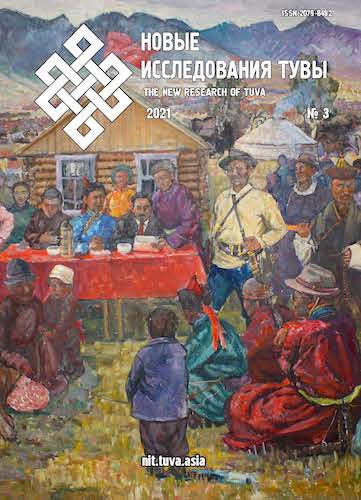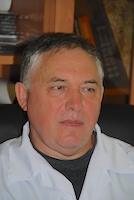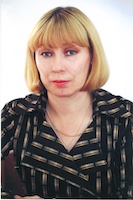Changes in adaptive anthropological characteristics in Tuvan youth due to socio-economic factors
DOI:
https://doi.org/10.25178/nit.2021.3.12Keywords:
anthropoecology; adaptation; students; total body size; diameters of limb epiphysis; Tuva; Tuvans; socioeconomic factorsAbstract
The article is a comparative study of the total body sizes and diameters of limb segments in the student population of different regions of Tuva, given that the adaptive balance between human body and the environment is now set against the background of serious changes in social and humanitarian factors.
In 2015-2019, we collected anthropological data of students aged 17 to 26. The work was carried out at Tuvan State University, Kyzyl, according to a unified methodology. The previous dataset collected in 1976-1978 among the indigenous population in Todzhinsky, Mongun-Taiginsky and Erzinsky rayons was used for comparison, with only data for youth under 26 included into the sample. In order to improve its representativeness, the contingent born and living in different regions of Tuva was grouped by macro-region: Western, Southern, Eastern and Central.
The absence of statistically significant differences in total body sizes (with the exception of girls' chest circumference) among modern students living in different macro-regions allows us to conclude that changes have been happening in a relatively uniform way, even though the macro-regions are different in both geographical and socioeconomic sense. It should be noted, however, that those living in the western part of Tuva have shown a slightly larger value of all total body sizes in students of both sexes. An intergroup comparison of Tuvan students surveyed 40 years ago gave a slightly different result: significantly higher values were confirmed for the body height of young males and females living in the southern macro-region. The results obtained may be an indirect proof of the intensification of ontogenetic processes in the population of this part of the republic. This is also confirmed by the accelerated rates of previously described age-related changes in the skeletal structure of the hand. A similar trend was also recorded for the width of the distal epiphyses of human limbs. With an insignificant number of notable differences between macro-regions of the republic, a picture of secular positive shifts in the value of indicators is clearly recorded. No intergroup variation in the size of the diameters of the distal epiphyses has been recorded.
Based on the ecological studies of such populations, one can confidently assert that they display features of accelerated rates of biological growth and aging.
References
Aksianova, G. A. (2009) Osnovnye rezul'taty rasogeneticheskikh issledovanii v Tuve v XX stoletii (obzor literaturnykh istochnikov) [20th century population studies in Tuva: principal findings]. Arkheologia, etnografia i antropologia Evrazii, no. 4 (40), pp. 137–145. (In Russ.).
Alekseeva, T. I. (1977) Geograficheskaia sreda i biologiia cheloveka [Geographic environment and human biology]. Moscow, Mysl'. 307 р. (In Russ.).
Alekseeva, T. I. (1998) Adaptatsiia cheloveka v razlichnykh ekologicheskikh nishakh Zemli [Human adaptation in various ecological niches of the Earth]. Moscow, MNEPU Publ. 280 p. (In Russ.).
Anaiban, Z. V. (2009) Sotsial'no-ekonomicheskie protsessy v regionakh Iuzhnoi Sibiri i usloviia adaptatsii naseleniia k novym usloviiam zhizni [Social and economic processes in South Siberian regions and conditions of the population’s adaptation to the new living environments]. New Research of Tuva, no. 1–2, pp. 65–90. (In Russ.).
Anaiban, Z. V. (2010) Sotsial'naia adaptatsiia naseleniia Tuvy k sovremennym ekonomicheskim preobrazovaniiam [Social adaptation of the population of Tuva to modern economic transformations]. In: Upravlenie resursnym potentsialom regionov na baze geoinformatsionnykh tekhnologii [Managing the resource potential of region by means of geoinformation technologies]. Ed. by V. I. Lebedeb and E. A. Mamash. Kyzyl, TuvIKOPR. 138 p. Pp. 45–52. (In Russ.).
Anaiban, Z. V. (2020a) Dinamika razvitiia etnogeograficheskikh protsessov v postsovetskoi Tuve [The dynamics of ethno-demographic development in post-soviet Tuva]. Vestnik Instituta Vostokovedeniia RAN, no. 2, pp. 284–293. (In Russ.). DOI: https://www.doi.org/10.31696/2618-7302-2020-2-284-293
Anaiban, Z. V. (2020b) Sovremennaia migratsionnaia situatsiia v Respublike Tyva [Сontemporary state of affairs of migration in the republic of Tuva]. Science of Europe, No.4, pp. 62–66. (In Russ.).
Anaiban, Z. V. and Tiukhteneva, S. P. (2008) Etnokul'turnaia adaptatsiia naseleniia Iuzhnoi Sibiri, (sovrem. period) [Ethnocultural adaptation of the population of Southern Siberia in the contemporary period]. Moscow, Institut Vostokovedeniia RAN. 217 p. (In Russ.).
Antropoekologicheskie issledovaniia v Tuve [Anthropoecological research in Tuva] (1984). Ed. by T. I. Alekseeva and M. I. Uryson. Moscow, Nauka. 224 p. (In Russ.).
Antropoekologiia Tsentral'noi Azii [Anthropoecology of Central Asia] (2005). Ed. by T. I. Alekseeva et al. Moscow, Nauchnyi mir. 326 p. (In Russ.).
Batsevich, V. A. (2016) Sekuliarnaia i vozrastnaia dinamika biologicheskikh kharakteristik v dvukh gruppakh sovremennogo naseleniia v raznykh ekologicheskikh usloviiakh [Secular and age-related changes in biological characteristics in two groups of modern population in different ecological environment]. Vestnik Moskovskogo universiteta. Seriia 23. Antropologiia, no. 4, pp. 110–117. (In Russ.).
Batsevich, V. A., Butovskaia, M. L. and Kobylianskii, E. D. (2018) Adaptivnyi status, tempy ontogeneza i dinamika morfologicheskikh priznakov v trekh skotovodcheskikh populiatsiiakh, sokhranivshikh traditsionnyi obraz zhizni [Rates of ontogenesis, dynamics of morphological changes and adaptive status in three present-day cattle-breeding communities which have preserved their traditional way of living]. Moscow University Anthropology Bulletin, no. 3, pp. 5–20. (In Russ.). DOI: https://www.doi.org/10.32521/2074-8132.2018.3.005-020
Batsevich, V. A., Krasil'nikova, V. A. and Permiakova, E. Yu. (2020) Adaptatsionnye vozmozhnosti studentov iz raznykh raionov Respubliki Tyva [Adaptation capabilities of students from different regions of the Republic of Tuva]. Moscow University Anthropology Bulletin, no. 3, pp. 19–31. (In Russ.). DOI: https://www.doi.org/10.32521/2074-8132.2020.3.019-031
Batsevich, V. A., Mashina, D. A. and Permiakova, E. Yu. (2020) Sotsial'no-ekonomicheskie preobrazovaniia na territorii Tyvy i izmeneniia adaptivnykh biologicheskikh kharakteristik u korennogo naseleniia [Socio-economic transformations on the territory of Tuva and changes in adaptive biological characteristics of the indigenous population]. Moscow University Anthropology Bulletin, no. 4, pp. 29–31. (In Russ.). DOI: https://www.doi.org/10.32521/2074-8132.2020.4.020-031
Batsevich, V. A. and Pavlovskii, O. M. (2007) Izmeneniia sotsial'nykh uslovii i ritm ontogeneza v populiatsiiakh cheloveka [Changes in social conditions and the rhythm of ontogenesis in human populations]. Voprosy antropologii, vol. 93, pp. 3–17. (In Russ.).
Batsevich, V. A., Pavlovskii, O. M., Mansurov, F. G. and Yasina, O. V. (2009) Regional'nye aspekty antropoekologii i dinamika ontogeneza v populiatsiiakh cheloveka [Regional aspects of anthropoecology and dynamics of ontogenesis in human populations]. In: Rasy i narody: sovremennye etnicheskie i rasovye problemy: ezhegodnik In-ta etnologii i antropologii im. N.N. Miklukho-Maklaia RAN [Races and Peoples: Contemporary Ethnic and Racial Problems: Yearbook of the N.N. Miklouho-Maclay Institute of Ethnology and Anthropology], vol. 34. pp. 78–115. (In Russ.).
Batsevich, V. A. and Yasina, O. V. (2000) Tempy ontogeneza u naseleniia Mongolii [Rates of ontogenesis in the population of Mongolia]. Voprosy antropologii, vol. 90, pp. 104–114. (In Russ.).
Batsevich, V. A. and Yasina, O. V. (2018) Dinamika tempov ontogeneza i razmerov tela u detskogo sel'skogo chuvashskogo naseleniia v period so vtoroi poloviny XIX veka i do kontsa XX veka [Ontogenesis rates and body size dynamics in children of rural Chuvashia from the second half of 19th to the end of 20th century]. Moscow University Anthropology Bulletin, no 4. pp. 5–22. (In Russ.). DOI: https://www.doi.org/10.32521/2074-8132.2018.4.005-022
Bogdanova, V. I. (1986) Antropologicheskii sostav i voprosy proiskhozhdeniia tuvintsev [Anthropological composition and questions of the origin of Tuvans]. In: Problemy antropologii drevnego i sovremennogo naseleniia Sovetskoi Azii [Problems of anthropology of the ancient and modern population of Soviet Asia]. Ed. by V. P. Alexeev. Novosibirsk, Nauka. 191 p. Pp. 108–162. (In Russ.).
Budilova, E. V., Lagutin, M. B. and Migranova L. A. (2015) Dinamika populiatsionnogo zdorov'ia naseleniia Rossii (2005–2013 gg.) [Dynamics of population health in Russia in 2005-2013]. Narodonaselenie, no. 3, pp. 99–110. (In Russ.).
Buduk-ool, L. K. (2008) Regional'nye osobennosti funktsional'nogo statusa studentov, prozhivaiushchikh v Respublike Tyva [Regional features of the functional status of the students living in the Republic of Tuva]. Ekologiia cheloveka, no. 1, pp. 26–30. (In Russ.).
Buduk-ool, L. K. and Aizman, R. I. (2009) Fizicheskoe razvitie i zdorov'e studentov v diskomfortnykh klimatogeograficheskikh usloviiakh prozhivaniia [Physical build and health of students under uncomfortable climatic and geographic living conditions]. Kazanskii meditsinskii zhurnal, vol. 90, no. 4, pp. 567–569. (In Russ.).
Istoriia Tuvy [The History Of Tuva] (2016): in 3 vols. / ed. by V. A. Lamin. Novosibirsk, Nauka. Vol. 3. 455 p. (In Russ.).
Kan, V. S. (2016) Etnosotsial'nyi profil' tuvintsev [Ethnosocial profile of Tuvans]. New Research of Tuva, no. 2, pp. 52–72 (In Russ.).
Krasil'nikova, V. A., Buduk-ool, L. K. and Aizman, R. I. (2008) Morfofunktsional'noe razvitie shkol'nikov tuvinskoi i russkoi natsional'nostei [Morphofunctional development of Tuvan and Russian schoolchildren]. Fiziologiia cheloveka, vol. 34, no. 1, pp. 74–81. (In Russ.).
Maurer, A. M., Batsevich, V. A., Permiakova, E. Yu. and Yasina, O. V. (2020) Sravnitel'nye issledovaniia vozrastnoi i vremennoi dinamiki kefalometricheskikh priznakov i antropologicheskaia fotografiia u sovremennykh tuvinskikh shkol'nikov pri ekologicheskikh izmeneniiakh v populiatsiiakh [A comparative study of age and temporal dynamics of cephalometric characteristics and anthropological photography in modern Tuvan schoolchildren under environmental changes in populations]. New Research of Tuva, no. 4. pp. 104–119. (In Russ.). DOI: https://doi.org/10.25178/nit.2020.4.8
Khrisanfova, E. N. and Perevozchikov, I. V. (2002) Antropologiia [Anthropology]. Moscow, MGU Publ. 400 р. (In Russ.).
Yamskov, A. N. (2005) Kontseptsiia ekologicheskoi nishi v etnoekologii [The concept of an ecological niche in ethnoecology]. Vestnik MGPU, no 2 (9), pp. 48–60. (In Russ.).
A century of trends in adult human height. NCD Risk Factor Collaboration (NCD-RisC) (2019) eLife; 5: e13410. DOI: https://www.doi.org/10.7554/eLife.13410
Barker, D. J. and Thornburg, K. L. (2013) Placental programming of chronic diseases, cancer and lifespan: a review. Placenta, Vol. 34 (10), pp. 841–845. DOI: https://www.doi.org/10.1016/j.placenta.2013.07.063
Batsevich, V. A., Yasina, O. V. and Sukhova, A. V. (2018) Secular and age-related dynamics of biological characteristics in the rural population of Mongolia: a study of environmental adaptation. Archaeology, Ethnology and Anthropology of Eurasia, vol. 46 (1), pp. 144–153. DOI: https://doi.org/10.17746/1563-0110.2018.46.1.144-153
Brüne, M. and Hochberg, Z. (2013) Secular trends in new childhood epidemics: insights from evolutionary medicine. BMC Med., vol. 11, p. 226. DOI: https://www.doi.org/10.1186/1741-7015-11-226
Bunak, V. V. (1928) Le Tannou-Touva. In: Internationales Archiv fur Ethnographie. Leiden. Bd. 29. R. 1–16. (In Deuch).
Eriksson, S., Graf, E. H., Dahl, V., Strain, M. C., Yukl, S. A., Lysenko, E. S., Bosch, R. J., Lai, J., Chioma, S., Emad, F., Abdel-Mohsen, M., Hoh, R., Hecht, F., Hunt, P., Somsouk, M., Wong, J., Johnston, R., Siliciano, R. F., Richman, D. D., O'Doherty, U., Palmer, S., Deeks, S. G. and Siliciano, J. D. (2013) Comparative analysis of measures of viral reservoirs in HIV-1 eradication studies. PLoS Pathog., vol. 9 (2), e1003174. DOI: https://www.doi.org/10.1371/journal.ppat.1003174
Eveleth, P. B. and Tanner J. M. (1990) Worldwide variation and human growth. 2nd ed. Cambridge University Press. 268 p.
Hermanussen, M. (2013) Auxology. Studying human growth and development. Schweizerbart, Stuttgart. 324 p.
Katzmarzyk, P. T. and Leonard, W. R. (1998) Climatic influences on human body size and proportions: Ecological adaptations and secular trends. American Journal of Physical Anthropology, vol. 106, no. 4, pp. 483–503.
Malina, R. M. (2004) Secular trends in growth, maturation and physical performance: A review. Przegląd Antropologiczny — Anthropological Review, vol. 67, pp. 3–31.
Mumm, R., Godina, E., Kozie, S. and Musalek, M. (2018) External skeletal robusticity of children and adolescents — European references from birth to adulthood and international comparisons. Anthropologischer Anzeiger, vol. 74, no. 5, pp. 383–391. DOI: https://www.doi.org/10.1127/anthranz/2018/0826
Musalek, M., Pařízková, J., Godina, E., Bondareva, E., Kokštejn, J., Jírovec, J. and Vokounová, Š. (2018) Poor skeletal robustness on lower extremities and weak lean mass development on upper arm and calf: Normal weight obesity. Frontiers in Pediatrics, vol. 6, p. 371. DOI: https://www.doi.org/10.3389/fped.2018.00371
Quetеlet, A. (1870) Anthropometrie ou mesure des différentes facultés de l'homme. Bruxelas. 496 p. (In French).
Roche, A. F. and Sun, S. S. (2003) Human Growth: Assessment and Interpretation. Cambridge University Press. 311 p.
Published
How to Cite
For citation:
Batsevich V. A., Mashina D. A., Krasil’nikova V. A., Yasina O. V. and Permiakova , E. Yu.Izmeneniia antropologicheskikh kharakteristik molodezhi Tuvy v sviazi s vliianiem sotsial’no-ekonomicheskikh faktorov [Changes in adaptive anthropological characteristics in Tuvan youth due to socio-economic factors]. New Research of Tuva, 2021, no. 3, pp. 148‑163. DOI: https://www.doi.org/10.25178/nit.2021.3.12
Issue
Section
Copyright (c) 2021 Журнал "Новые исследования Тувы" (составление)

This work is licensed under a Creative Commons Attribution-NonCommercial 4.0 International License.

Author(s) license holder(s) grant rights for their work to the journal (grantee of a license) under the simple non-exclusive open license in accordance with Art. 1286.1 «Open license for a research work, work of literature or fine arts», Civil Code of the Russian Federation.
New Research of Tuva publishes articles under the Creative Commons Attribution-NonCommercial license (CC BY-NC).
Since it is an open license, author(s) reserve the right to upload the article to their institutional repository, submit it to another journal (if it allows republications), or republish it on their own website (in full, or in part).
However, several conditions apply here:
a) The republished version must always contain the name(s) and affiliation(s) of the author(s), the original title and the hyperlink to the original version on the New Research of Tuva website;
b) It must be in open access, free of charge, and no category of readers must be in any way whatsoever advantaged over general readership.
c) should the contribution be submitted elsewhere by its author(s) without substantial modification (30% or more of original text unchanged), the body of the article should contain a disclaimer that the original version was published in New Research of Tuva (with a link to the respective page)
The CC-BY-NC is a non-revocable license which applies worldwide and lasts for the duration of the work’s copyright.













